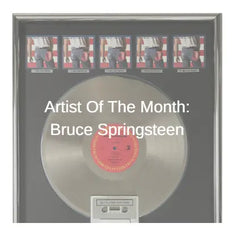In this article we take a close look inside every detail of RIAA "white matte" awards, the style of RIAA awards made exclusively by the New York Frame & Picture Co. (NYF&P Co) from 1964 to 1974/early 1975 when the RIAA mandated a design change to the "floater" style.
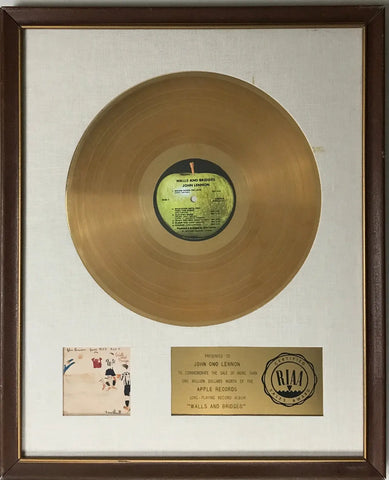
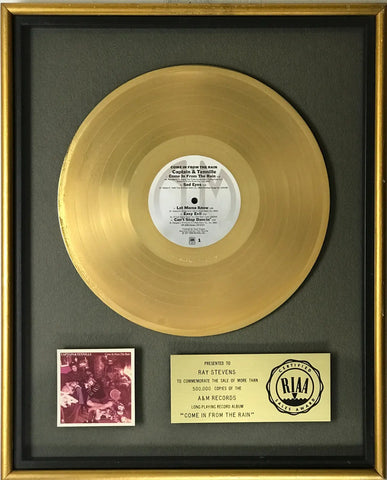
1964-early 1975 RIAA "white matte" award (left/top), 1975-81 "floater" award (right/bottom)
The purpose of this article is to help collectors of these awards know if a white matte award they may be considering is authentic.
We thought long and hard before planning this article because we don't want to arm those intent on making fake awards with any information. However, we felt this article would be safe to put out there simply because the aging that must be present on a real white matte is next to impossible to replicate.
More about that later in this article but keep in mind throughout your assessment of any white matte that it has to be at least 51 years old at this point in 2025. This is why you probably won't see us writing an article like this about newer awards -- it is too hard to rely on aged-appearance evidence on a newer award.
At MusicGoldmine.com we have done a great deal of work to learn every detail of these and all RIAA awards. As relates to white matte awards, this includes recording an interview with Ted Howell Jr., owner of NYF&P Co. throughout the entire time that the company made RIAA awards, in 2019 before his death in 2021. In addition, his son (also named Ted Howell) who worked in his father's shop helping make the awards from his early youth through his twenties, has also been a great source of first-hand information.
This information, coupled with tearing apart some of these plaques has provided us an excellent background to assess the authenticity of these awards. We hope this article will help you, the collector. All of these details are important and it is crucial that all of these details check out for an award to be confirmed authentic. So strap in, since this is a lengthy cache of information...
The Basics
The design of RIAA white matte awards was very strictly controlled by the RIAA and, as mentioned, the only company licensed to make them was NYF&P Co. They all had to be the same size. The album awards had to be 17.5" x 21.5" (44.5 cm x 54.6 cm). Single (45 rpm) awards had to be 13" x 17.25" (33 cm x 43.8). The album versions had to be configured exactly as you see in the above example, and as you see here in an example of a single award:
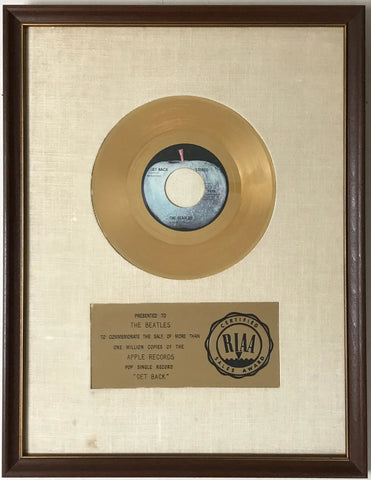
Almost every other element of these awards also remained the same for the entire time they were made. The only differences over time were of the type of matte used, the manufacturer of the gold-plated metal mother discs, and the address on the NYF&P Co. labels since the company moved from one address to another in New York City partway through the 1964-75 time period. There was also one other anomaly that occurred in 1969 which we'll cover below.
Album awards were authorized by the RIAA when the issuing record label could provide the RIAA with auditable sales data showing that "more than $1 million dollars worth" of the albums had been sold. Single awards were authorized when the issuing record label could provide the RIAA with auditable sales data showing that "more than one million copies" of the single had been sold.
How Many Were Made Of Each Title?
A common question collectors ask is: How many were made of each? The RIAA has released no information on this so completely fact-based answers are hard to find. Those who owned and worked at NYF&P Co. collectors recall and many collectors believe that around 5 to 25 of each title were produced, depending on how many people the artist, label or the executives/artist managers wanted to recognize and/or thank.
There is no doubt that the numbers of people who received awards for the most successful and popular artists exceeded those for less successful artists. Unfortunately, only anecdotal evidence exists on this point beyond the memory of those who owned and worked at NYF&P Co.
Award Presentation
While today's RIAA awards can be found in the names of the artist, manager, producer, engineer, studio, radio stations, individual record industry executives of all types and more, white matte presentations were much more limited. At that time, and especially in the earliest years that white mattes were produced, the list more typically was limited to the artist's name, individual group member names, or the record label.
As the years went on during the white matte era, the awards can also be found presented to a key producer or engineer (for example Beatles engineer Geoff Emerick), songwriter (such as Bernie Taupin), manager (for example Led Zeppelin's Peter Grant), or executive (many record label promotions and music publishing executives were named on white matte awards).
Still later, key industry outside of the labels received white matte awards. One example is Kal Rudman, who founded radio tip sheet Friday Morning Quarterback (FMQB).
Once again the artist was king, however, and what they wanted was accommodated. When lifelong Elton John collaborator and lyricist Bernie Taupin asked for an award to be issued in his parents' names, the label of course obliged and ordered it for him:
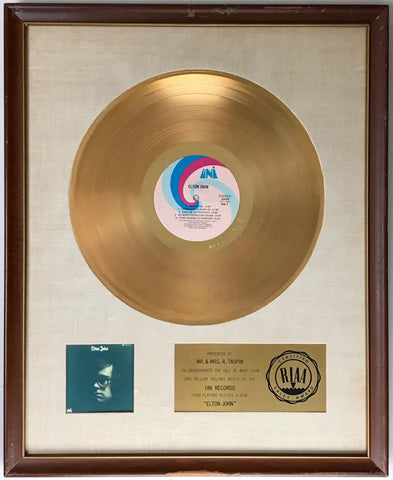
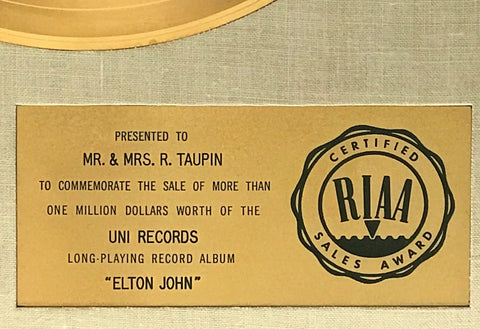
Elton John debut album RIAA white matte award owned by Bernie Taupin presented to his parents. Acquired by MusicGoldmine.com after initially coming from a sale personally arranged by Bernie Taupin of his own awards.
Another common question is: Could anyone outside of the artist get awards in the artist's name? The evidence on this is fairly clearly yes. Ted Howell from NYF&P Co. indicated that the labels could order as many as they wanted in the artist's name and often did, because executives enjoyed the cachet of the artist's name on the plaque on their office wall.
Also, an artist had (and has currently today also) every right to order as many plaques as they want and gift them to whoever they chose, whether they be execs, roadies, friends, loved ones, or simply a friend.
There are also numerous examples of artists selling their own awards -- or one copy of their own awards since they may have multiples -- to raise money for charity or for other personal reasons. Bill Wyman of the Rolling Stones has sold his own awards and clearly has multiple copies presented to him. Known as an avid memorabilia collector himself, he also has or has had Charlie Watts- and Mick Taylor-presented awards he has sold through auctions. Bernie Taupin sold all of his awards in the last few years and there are many other examples of this. Also, it is very common for the estates of deceased artists to sell their awards. We know, because we have acquired awards in all of the above ways.
These are all examples of how artist-presented awards have landed into the collector marketplace.
And here's another example from our own experience:
Someone who worked for Black Sabbath for 16 years was gifted various awards by Sabbath's Tony Iommi. These included a RIAA white matte album award for Sabbath's 1972 debut album in Iommi's own name (although misspelled). This person, whose name we will not reveal for client confidentiality reasons, opened up the award and asked Iommi to sign it, which he did. In 2020 this person became a consignment client of ours, asking us to sell the award for him. We did just that and it sold quickly for a healthy sum:
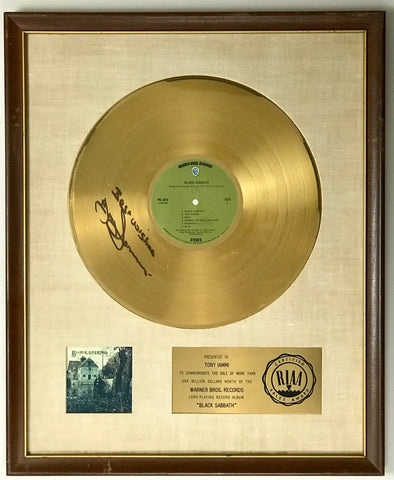
The bottom line is that there are many versions of how RIAA awards in an artist's name can land into the collector market.
Provenance
Now on to another, separate issue: Does this mean that the artist's name on an RIAA award means that they ever owned or even touched it? Of course not. It does not necessarily prove this. That issue can only be resolved by evidence of provenance. Direct provenance is only occasionally available for white matte awards, unfortunately. If one has a bona fide letter of provenance from a family member or other trusted source, it is a wonderful thing and the market value will clearly be higher.
We have a good story regarding provenance related to an award we acquired in 2020. It involved an RIAA white matte award presented to Jim Morrison of The Doors. The award came from Jim's lifelong friend Alain Ronay, who was also the photographer who took some of the last photos of Morrison in Paris before his death. To read about it, see the article here.
For all the other awards that don't come with provenance, however, one must rely on whether they are constructed correctly, have correct certification, are appropriately aged, etc., etc. as detailed in this article.
Frame and Glass
The frames were made of solid dark walnut with a thin gold painted bead on the inner edge. The profile of the frame has to be concave, not convex. Look at this example for a correct frame and notice the scrapes and mars -- that appears to be "good aging" -- as opposed to the pristine incorrect frame with a convex profile at the bottom in this photo.
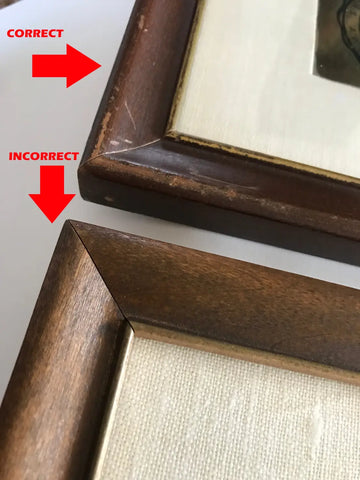
There are numerous reproduction frames out there to look out for in addition to the style above. Here is another example. The inner gold bead is incorrect, it is square instead of rounded:
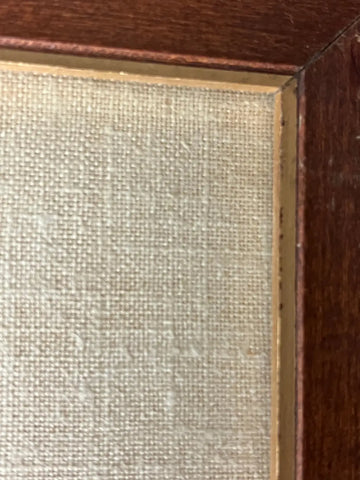
Above photo shows square inner gold bead indicating that this frame is inauthentic. Lower photo shows rounded inner gold bead on an authentic frame.
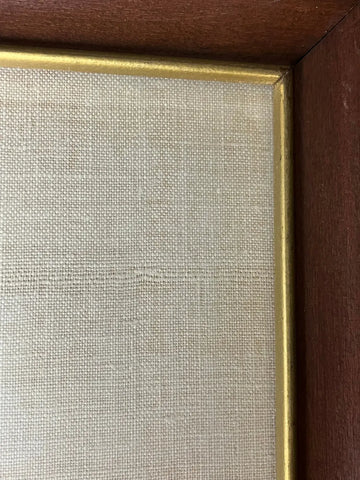
RIAA white matte awards have glass fronts, unlike awards from later time periods, including the following 1974-81 floater era, which featured plexiglass fronts. The glass is quite thin, has no modern features such as anti-glare or UV protection, and certainly breaks at times if an award is not transported properly.
Matte
Two different matte types were used over the years. From 1964 to early 1967 the awards were made with off-white Bainbridge #14 matte board, with its distinctive color and crisscross, burlap-like texture. The mattes were hand cut and often exhibit some shredding and unevenness on the edges like this example on a Dave Clark Five award from 1966:
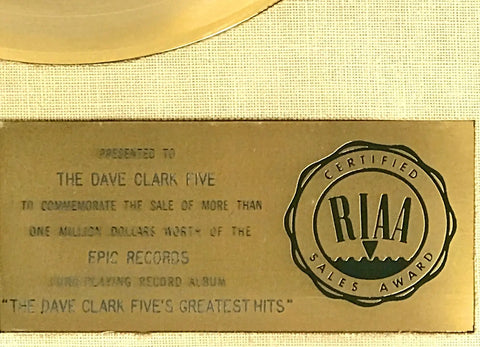
From 1967 through early 1975 white Miller brand board was used. This material also has a texture, but it is slightly smoother and has a whiter appearance. These mattes were die cut with a stamper machine. Here's an example from a 1968 Rolling Stones award:
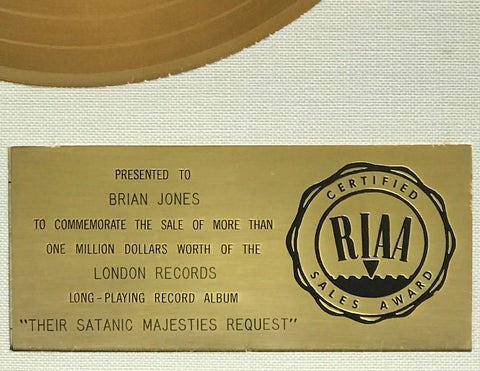
It's also notable that on both early and later white mattes, the disc and other elements were "matted in" as opposed to 1975-81 "floater" awards, where the elements are mounted on top of the matte on small cardboard blocks.
Here also is a side-by-side comparison from a little further away with the earlier Bainbridge #14 on the right/bottom, the later Miller on the left/top:
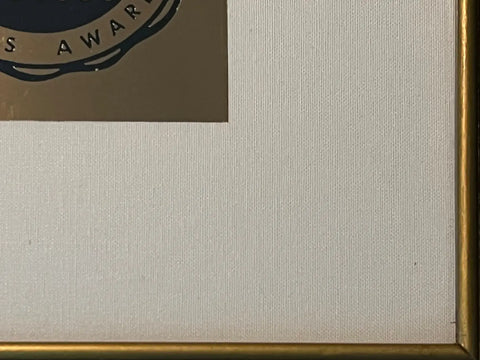
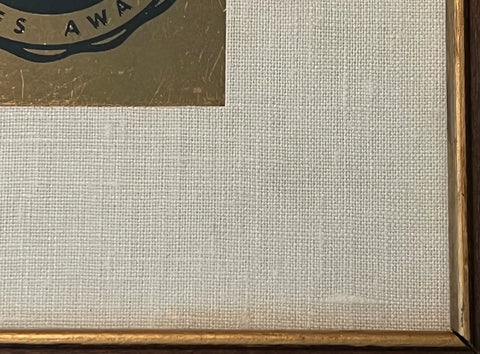
Final word on mattes is that they all age differently. One reason for the switch from Bainbridge to Miller is that the composition of the Bainbridge matte material resulted in some discoloration over time. However, both types of mattes can appear in different shades on different awards due to display conditions. These include amount of sunlight they were exposed to over time, humidity, and other factors.
Presentation Plate
The presentation plates on white matte awards were acid-etched metal plates. This is opposed to floater-era awards on which silk screened plates were used.
One can see the difference in an acid-etched plate versus a silk screened plate most easily by placing a gold floater award next to the white matte award you are assessing. The black portions on the presentation plate on the white matte should have a slight bit of relief, i.e. an ever-so-slightly raised surface that is usually most apparent when looking at the RIAA logo. A light placed below or on the side of an award will also reveal the highlighted edges. Note the white glint on the left side of the RIAA logo letters:
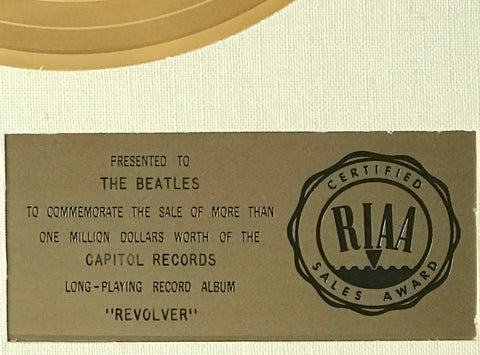
Here's another example:
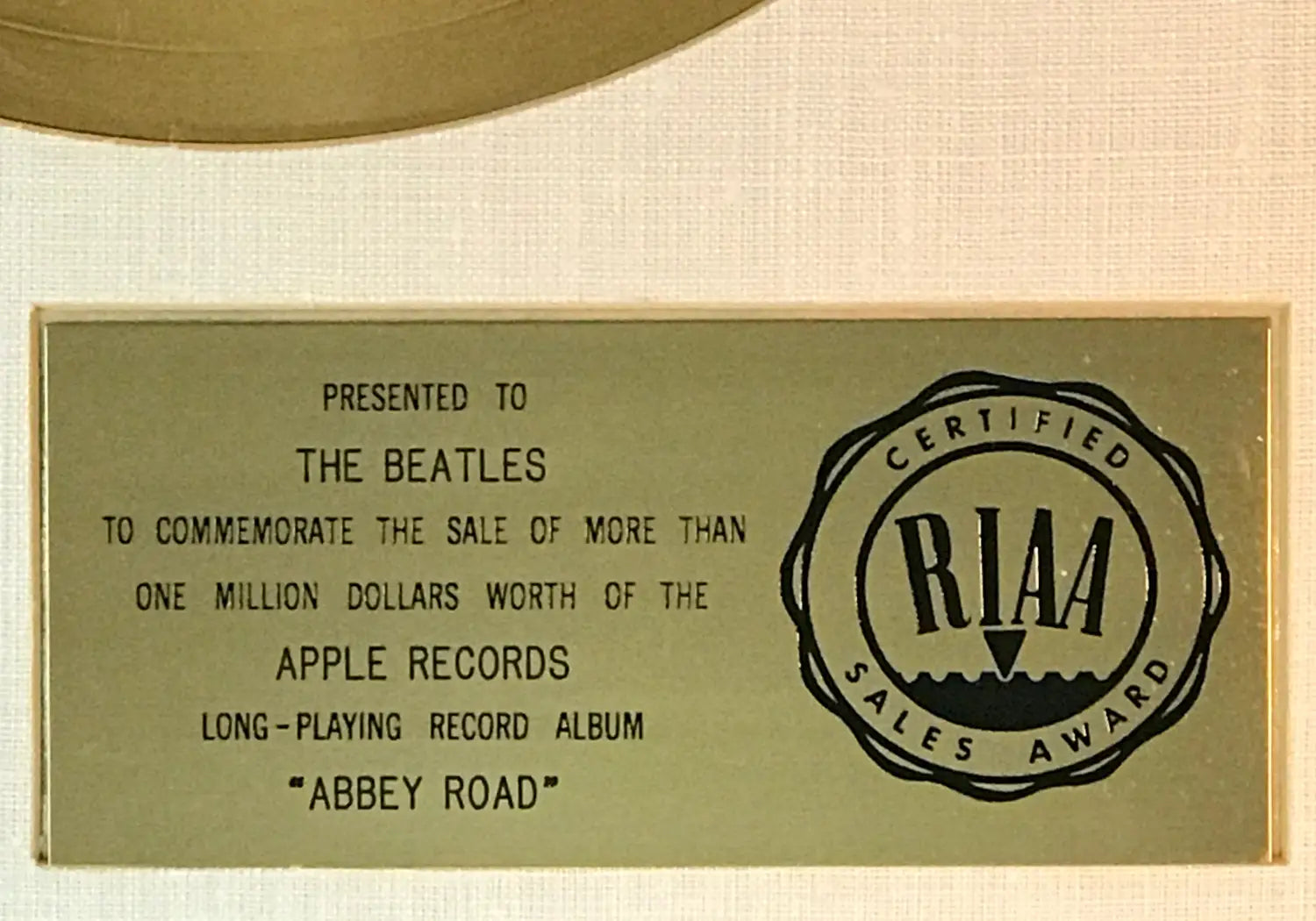
Note also the language on these Beatles Revolver and Abbey Road Gold Album awards. Like above, the language on an album award must always read:
PRESENTED TO
[award recipient]
TO COMMEMORATE THE SALE OF MORE THAN ONE MILLION DOLLARS WORTH OF THE
[XXX record label]
LONG-PLAYING RECORD ALBUM
[album title]
Here's a presentation plate on a single award for The Rascals "Beautiful Morning":
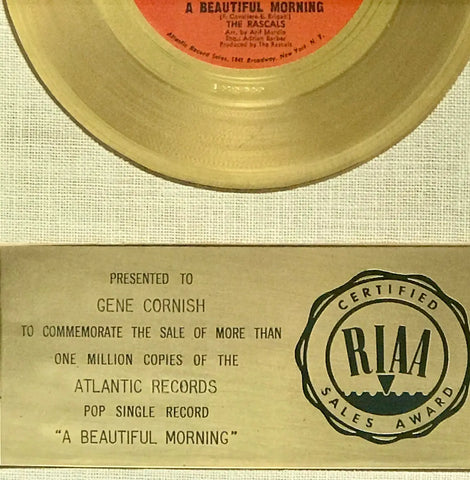
Note that the language on a single the language must always read:
PRESENTED TO
[award recipient]
TO COMMEMORATE THE SALE OF MORE THAN ONE MILLION COPIES OF THE
[XXX record label]
SINGLE RECORD (or sometimes) POP SINGLE RECORD
["song title"]
As to fonts, in the plate examples above one can observe the slight difference in fonts used. Some are thicker like on the Beatles Revolver award, some are thinner like the Rascals single award, for example. Some collectors think that these differences are telling but, according to Ted Howell of the NYF&P Co., different trophy shops in New York City were used over the years to engrave the specific award information on the plates which explains the difference in appearance of this text. This is in contrast to the basic language indicated above, which was pre-etched onto hundreds of plates at a time and which is accordingly much more consistent.
Similarly, some collectors have noticed the different styles of quotation marks around album or song titles on different awards. For example, observe also on the Beatles Revolver vs. the Beatles Abbey Road Rascals "Beautiful Morning" plates above the two different styles of quotation marks. However, the same issue -- different trophy shops over time -- explains how these differences could have occurred on different awards. Several types of quotation marks can be seen on different white matte awards.
Gold Disc
First, note carefully that the RIAA did not introduce their Platinum certification until 1976 so it is not possible for any white matte to have a platinum disc.
Second, note that all gold records in white mattes were gold-plated metal masters. These tend to make the awards heavier than fake "white matte" awards made with gold coated plastic discs. Plastic discs only went into use in RIAA awards after the 1975-81 "floater" era ended.
One way to know if a metal disc is present-- if an award has its' backing paper torn off (which is not always the case of course) -- is to see that it looks like this from the back. This is an album award with the backing paper gone and the cardboard backer which is held in by small nails removed:
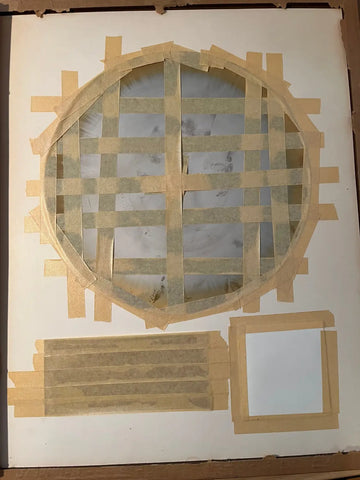
Note the distinctive silver-colored metal disc peering through the grid of masking tape. They used simple masking tape you ask? Yes they did, and this is what it looks like when it is about 50 years old. Still holding on well on this one at least.
The junior Ted Howell of NYF&P Co. (the owner's son) describes spending good parts of his teen years working in his father's shop taping these very gold records in this exact same crisscross way each time. The presentation plate and album miniature image are also held in with the same tape. (We'll talk more about the album miniature below).
Here's the back view of an older pre-1966 single award with the more yellowed back of its' Bainbridge #14 matte board. Note the small piece of matte board taped behind the center hole of the record discs on both this and the album award, so that matte board shows through the hole:
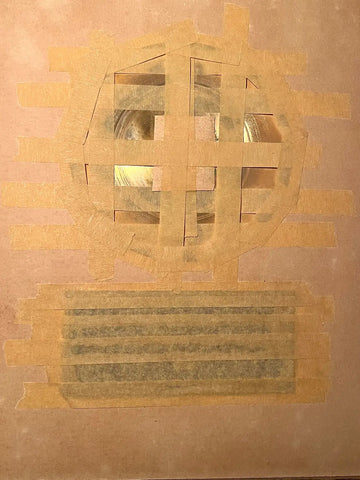
More than one manufacturer of gold discs was used. The most distinctive is the Disc Award Ltd. company, with the dragon logo appearing in the dead wax area:
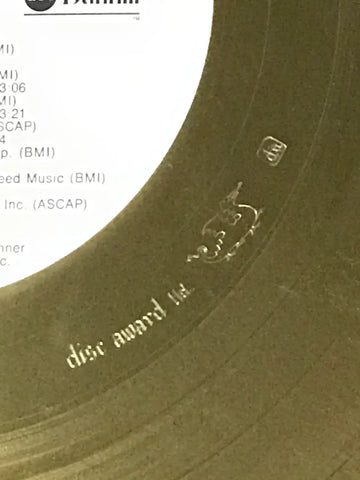
However, while a good many white matte awards feature discs made by this manufacturer, others were also used on which no logos appear. As to other numbers that may appear in the dead wax area, there is no consistent information that can be gleaned from them. Occasionally, one can see a tiny engraving such as "Mastered By Capitol" but engraved notations are fairly rare.
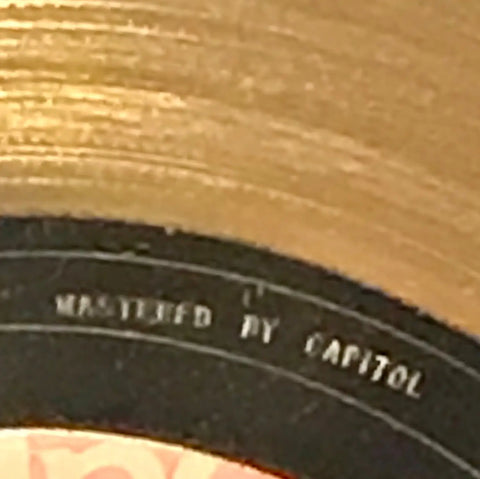
Album Miniature
Checking that the album miniature appears exactly as the album was originally released in the year of the award is a good idea. i.e. It cannot be a reissue album cover. Also, these were printed on what started out as somewhat glossy Kodak brand photo paper. They were not printed or photocopied. The do often fade to an extent but the fading is like an old photo fades, for lack of a better description. The colors often appear faded:
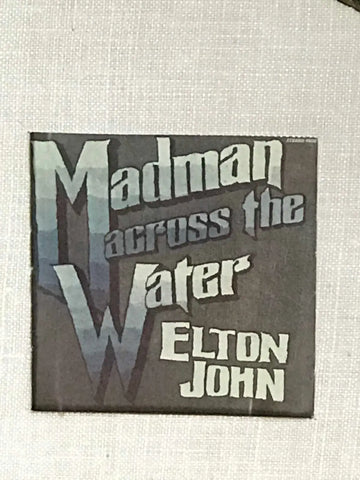
If you have the advantage of seeing the miniature from the back (usually not possible) you should see the Kodak logos on the back like this one, on which some new masking tape has been applied to re-secure the miniature. Note also the old tape residue from the original masking tape. This should always be seen in what is always a 50+ year-old record award:
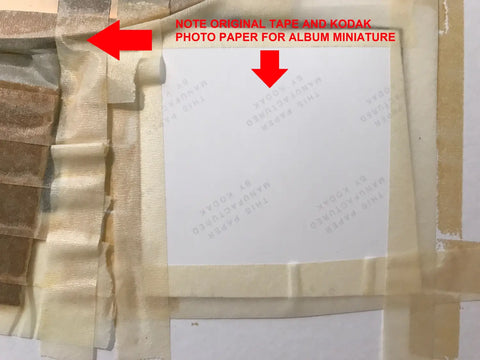
Backing Paper and New York Frame & Picture Co. manufacturer label
Best for collectors is when a NYF&P Co. sticker is still affixed like in the examples shown below. This is because it is an indicator that the award has most likely not been tampered with. However, while not always easy to detect, be on the lookout for labels newly glued onto new backing paper on the award.
The backing paper itself on a white matte award should be brittle, wrinkled or torn at least to some extent to make sense on a 50-year-old item. However, the reality is that some of these awards could have been rebacked in the 80s by NYF&P Co. themselves so, regardless the condition of the backing paper, it cannot be considered a 100% reliable indicator of originality.
Wire hangers attached to two small screw eyes were always the original hangers for white matte awards. Here's the back of Bernie Taupin's parents' award:

The address on the NYF&P Co. sticker is useful in determining when an award was made since the company moved locations at least once during the time they made white matte awards. Also, in the earlier white matte years, the sizes of the stickers used on 45 and LP awards were different and sometimes the smaller stickers were used on the album awards as well.
During 1969 the NYF&P Co. moved from 141 Fulton St. to 29 John St. in New York City. Knowing this helps to peg manufacture dates of awards that still have an original sticker affixed with these addresses. i.e. It can indicate that an award was made, or at least that its backing paper was installed, either pre-1969 or post-1969.
It's important to note, however, that the existence of a post-1969 NYF&P Co. label on a pre-1969 award does not necessarily indicate that the award is inauthentic. In fact, a decent number of the pre-1969 "early" white matte awards sold by major auction houses today have 29 John St. stickers on them. Why is this? It is only speculation but it could be that early backing papers quickly disintegrated and had to be replaced by NYF&P. Ted Howell (the senior) relayed numerous stories of labels being quite demanding and returning awards they has ordered for one repair or another. In some cases these white matte awards could have been restored by NYF&P post 1969 after being damaged or getting dirty.
Ultimately, the only thing the existence of a 29 John Street sticker on a white matte award proves is either that it was first manufactured from 1969 to early 1975 or that it was rebacked during that time period. Since the same 29 John St. stickers were used on 1975-84 floater awards, the rebacking of a white matte could also have been done during that period.
The first image here shows the sticker on an LP award for War Live album from 1973, on which slightly larger labels were used. The 29 John St. address also dates it to post-1969 since the company was at other locations prior to 1969:
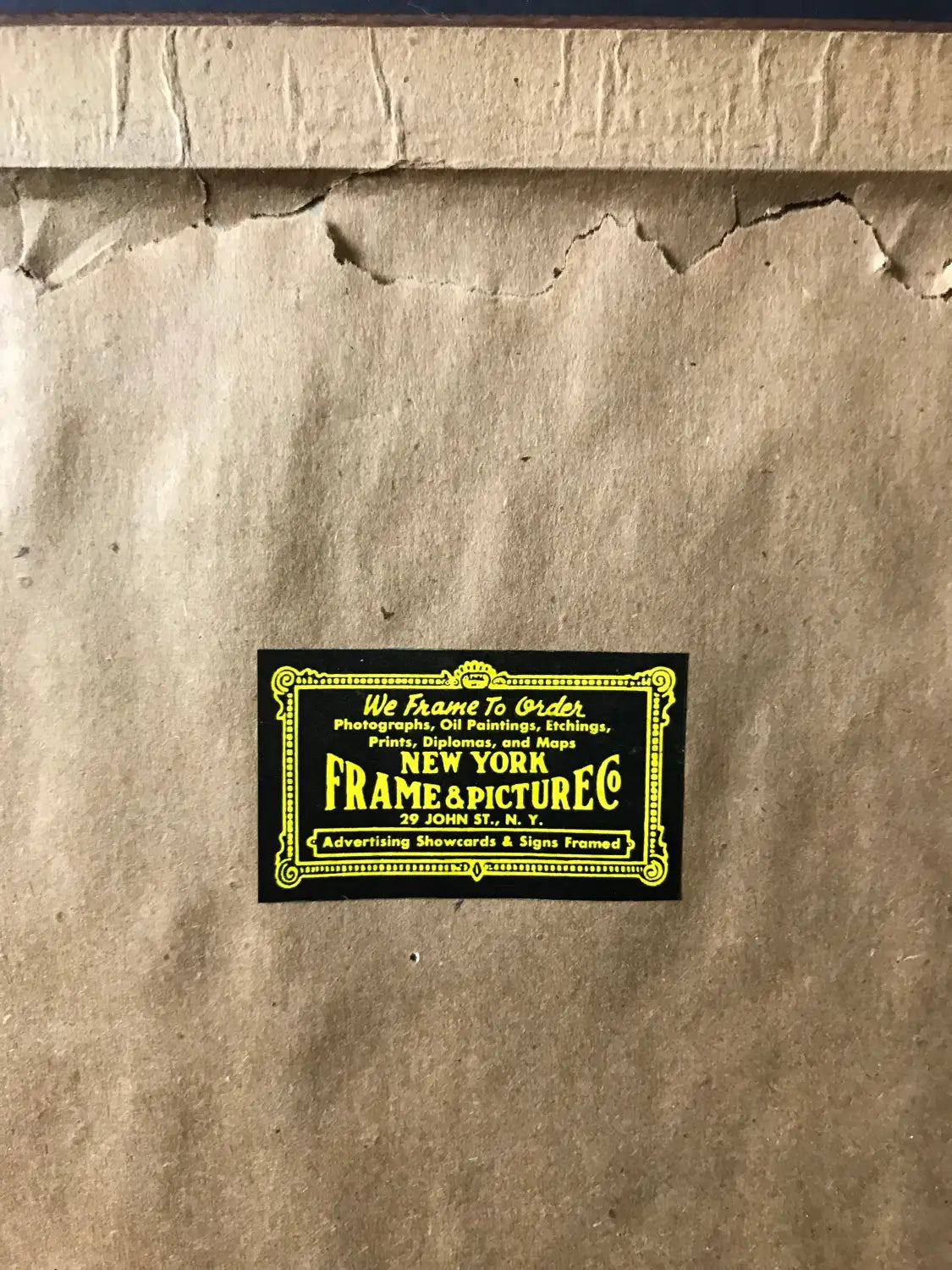
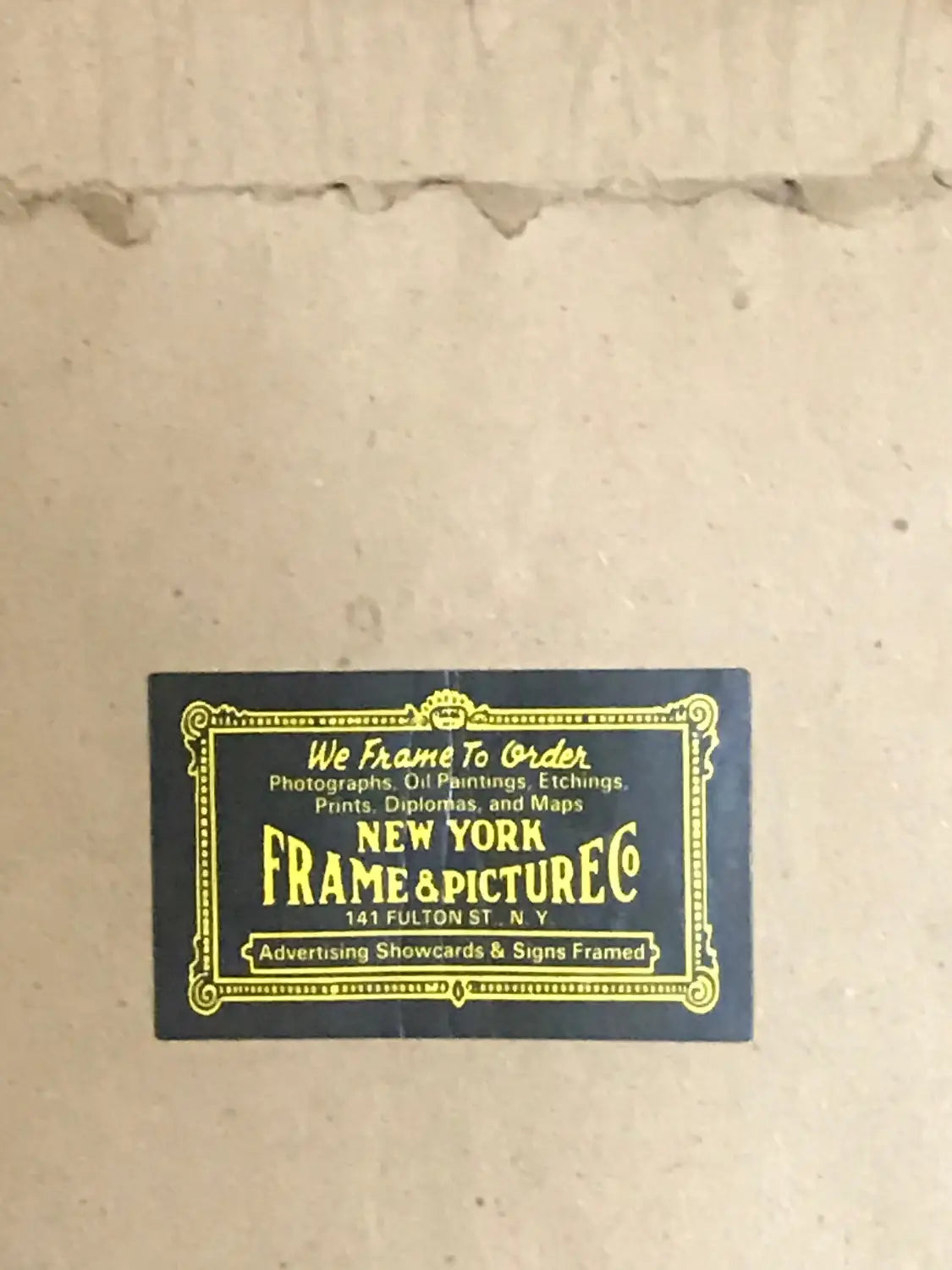
This third image shows the smaller sticker sometimes seen on 45 awards. Even though the sticker in this example is partially damaged, it's existence helps to indicate award authenticity. Note that this is a pre-1969 NYF&P Co. 141 Fulton St. address on this early white matte award. This is also an example of the simpler label design sometimes seen (this is from a 1968 Rascals award for "People Got To Be Free"):
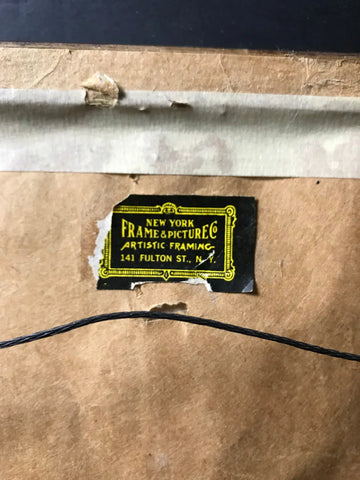
Label-wise, second best is when an original backing paper has survived with the sticker having fallen off, as long as there is a sticker residue spot of the correct size and shape where it was once located. This is normally in the upper middle of the back.
For example, despite the taped up tears on three sides, the condition of the award back below is more desirable to many collectors than a changed backing paper because you can see the proper location and size sticker residue near the top middle. The idea is that this helped indicate an authentic award:
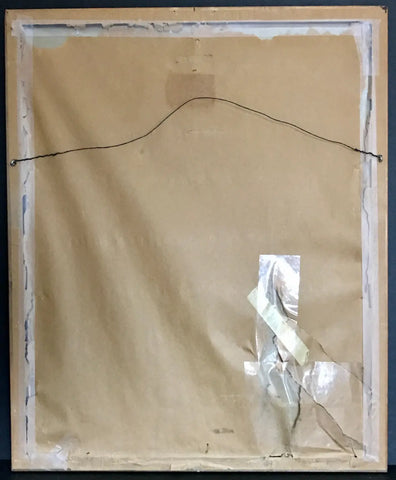
That said, some prefer to simply replace a torn backing paper. If this is done, it is recommended to: a) Take good photos of the original backing, and b) Leave the remainder of the original backing paper on and simply re-back over the original.
If repairs need to be done to the internals of an award (for example, re-attaching a presentation plate that has fallen off due to its glue drying out) and at least one side of the backing paper at the frame is intact, try and leave the intact side uncut. By doing this you can retain the original award backing paper. If it is still present, it's also best to try and retain the manufacturer sticker in its original location.
To close up the award, seal the three cut sides with brown paper tape or clear cellophane tape. Performing a repair in this way can help preserve the award's value for serious collectors. Here's an example of a 1971 white matte RIAA award post-repair (this was not a repair that we at MusicGoldmine performed). Note that the backing paper has not been cut on the top side:
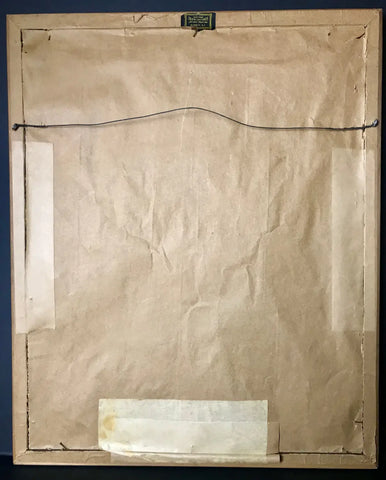
The "Summer of '69" Anomaly: Flipped Presentation Plates
One interesting anomaly in white matte awards occurred over a six month period from, roughly, Spring to Fall in 1969 when the position of the presentation plate and album miniature were flip flopped, with the plate located on the left of the award instead of the right. Here's an example of one of these unusual mid-1969 white mattes on the top for The Doors The Soft Parade, certified RIAA Gold on August 5, 1969 compared to a white matte made in 1970 on the bottom for The Doors Absolutely Live:
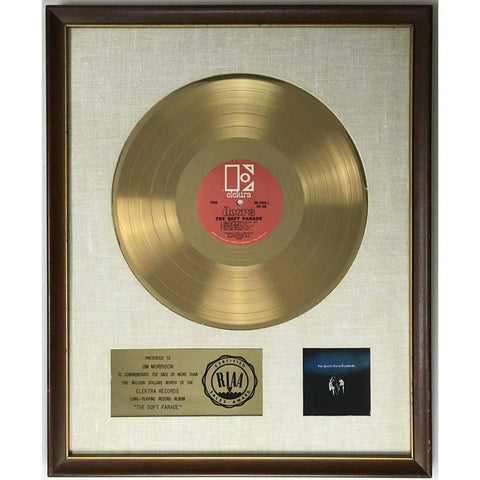
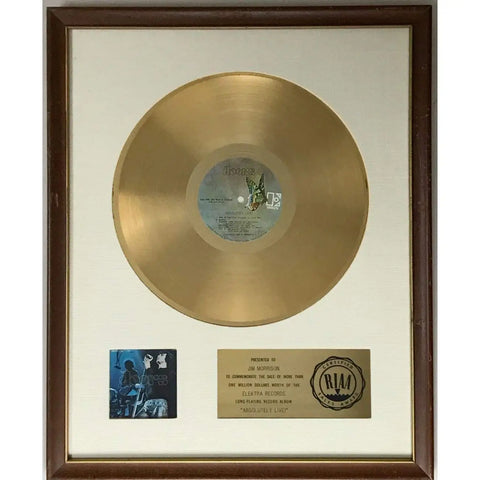
In talking to Ted Howell of NYF&P Co., he indicated that perhaps a batch of the mattes were die cut upside down and rather than discard them, they were used up until they ran out during this time period. However, this is only a theory and even though we spoke with those in the family business that made them, they were not sure. Not many of us who worked 50 years ago in a busy New York City frame shop would remember such a mundane detail either.
Other tips to determine authenticity
Nails: If you want to know whether an award has been opened, repaired or otherwise tampered with and you can see through tears in the backing paper, look for the original nails to be present. They should look like this:
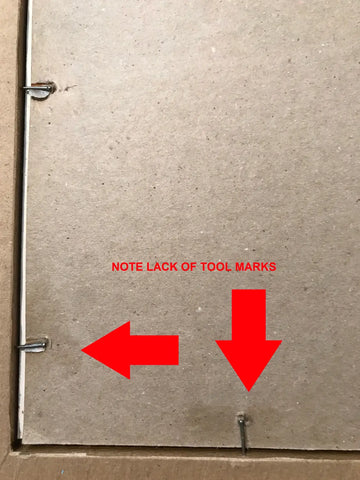
On the other hand, presuming you know that the inner backing cardboard is original, if you see tool marks like in the photo below it can be a sign that the nails may have been removed at some point and the internals of the award may have been altered or repaired. It is important to note that it is always possible, however, that the original work on the award may have needed to be redone for whatever reason. If you see this, it should only be used as evidence to look closely at other details of the award:
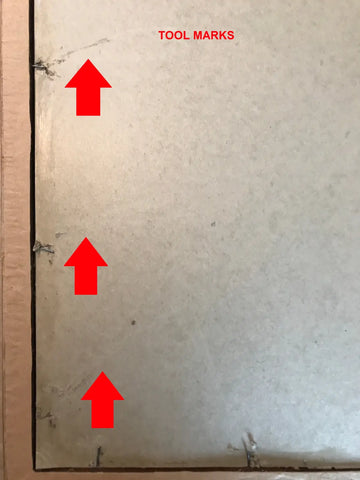
It's also worth noting that at times you will see modern framers points installed on a white matte, perhaps visible through a tear in the backing paper. Some dealers (including us) will at times add some framer's points to lend stability to an award that has loose internals due to the original nails losing their moorings. This reinforcement helps to prevent breakage of the glass and other damage from occurring. However, you should still be able to see evidence of nails present.
Opened and repaired white matte awards: Sometimes a white matte award has been opened and a repair has been done. This is most commonly because a component of the award comes unglued from the masking tape holding it from the rear.
This can happen with all components, but most commonly the record or presentation plate. The other issue that occurs is that the adhesive holding the record label onto the gold disc fails and the label falls off.
If repairs to fix these issues are done properly (such as using an acid-free adhesive to re-affix the record label), this shouldn't deter you from seeing the award as original. It may drop it on a grading scale from a 9 or 10 to a 7 or 8 in your mind but it is not a major issue as long as all the other components remain original.
A more serious repair would be to see the replacement of a matte. This is the most common component to degrade over time, especially if the award has been in humid climates and when the award's backing paper has been torn open. Sometimes you will note beveled cuts on holes made in the matte for the components. This is a likely indicator that the matte has been replaced, especially if you see this in 1968-74 award since the original mattes in those awards were die cut (stamped) and the cuts should be straight.
Once again, this shouldn't deter you from seeing the award as almost completely original. It may drop it on a grading scale further to a 6 or 7 but it is not a major issue as long as all the other components remain original.
What is important is that dealers inform you of any repairs that they are aware of. We as a dealer try to do this although it is often impossible to know for certain if, and what, repairs may have been done on an award if the work is done well. We do always try to observe and report what we see on any given award.
Aging, Aging, Aging
Simply put, does the award you are considering look 50+ years old? If not, it probably isn't.
A Final Word
While examining any RIAA white matte award, remember to assess it based on all the criteria above, not any one factor. You should always also check the RIAA certification of an award you are considering to determine the date it was certified to see if it makes sense. You can do this simply by searching at https://www.riaa.com/gold-platinum/
Also remember that each white matte was made in a workshop in the 1960s or early 1970s by craftsmen without computerized equipment. These are handcrafted items and slight variation can occur both in terms of the materials and the construction of these awards.
While these NYF&P Co. workers are proudly displaying a pile of 1975 floater awards they just made for an ELO album, the scene was very much the same a few years earlier as they made white matte awards:
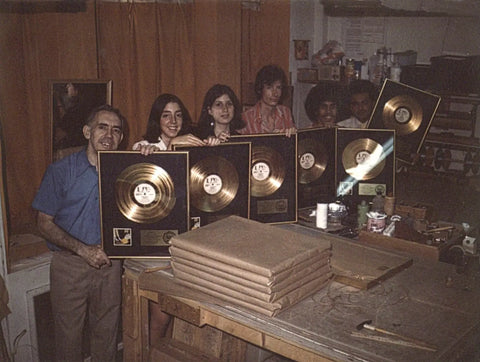
New York Frame & Picture Co. staff posing with freshly made RIAA awards, circa 1975 (Photo courtesy Ted Howell. Used with permission)
Good luck in your collecting, whether it be RIAA white mattes or other awards!
See our current selection of white matte RIAA awards here.
Feel free to share this article, but please only share in its entirety and leave all hyperlinks intact and active for copyright and credit reasons. All photos copyright MusicGoldmine.com. Photos of all awards and award details in this article are of awards that we have personally held in our hands.
Want more content like this? Sign up for our free MusicGoldmine.com newsletter here.
Important Notice/Disclaimer: While many record awards and music memorabilia items appreciate in value, others fall in value and MusicGoldmine.com makes no claims, express or implied, that any item will appreciate in value at any time in the future. Further, MusicGoldmine.com is not providing investment advice in any of its' content.

